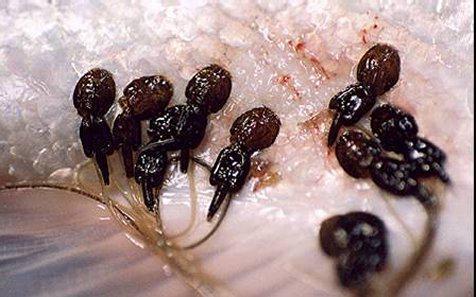You are here
Fish farmers "spinning" sea lice success, says NGO

March 22 2014
South Coast Today - Timothy Gillespie
A publicity campaign by the Atlantic Canada Fish Farmers Association(ACFFA) about the success of the region's industrial fish farms in combating sea lice infestations success is not telling the real story, according to some whose job it is to monitor fish and marine habitat health.
On the web site for ACFFA, the association says that, "After struggling through a few challenging years of high sea lice populations, our farmers are beginning to turn the corner in the management of these naturally occurring parasites. The progress is thanks to the full implementation of a collaborative and integrated pest management plan."
“Salmon farms can control sea lice when they have access to the right management options,” Pamela Parker, executive director of the Atlantic Canada Fish Farmers Association, said in a recent interview with the Chronicle Herald.
In the business story entitled "Fish farmers hail reported success of sea lice control", Parker parroted much of the public relations script used on the association web site
The association’s take on the audit results met with some skepticism, including with staff at the Ecology Action Centre in Halifax, according to the Herald.
“It’s an inappropriately positive spin on the available information about a contentious issue,” said the centre’s Rob Johnson.
Johnson is an acknowleged expert on expert also the Atlantic Coordinator for SeaChoice, an NGO which has, according to their web site, developed Canada’s most comprehensive sustainable seafood program.
Launched in 2006, SeaChoice was created to help Canadian businesses and shoppers take an active role in supporting sustainable fisheries and aquaculture at all levels of the seafood supply chain.
Johnsoln told the Herald, “Treatment products in the context of sea lice control refers to the use of toxic chemicals which are dumped into the marine environment and affect other species.”
He said the salmon farming industry in Atlantic Canada has long been lobbying federal regulators for increased access to a variety of toxic chemicals that have proven ineffective in other jurisdictions like Norway, Scotland and Chile.
“The problem is the out-of-date nature of the open-net, pen-style of salmon farming used by the industry today to keep costs down. It is an outmoded technology,” he said.
“Where there are abnormally high concentrations of fish like there are in open-net pens, parasites (like sea lice) will proliferate.”
Johnson said infestations of parasites lead to culls of infected fish farm stocks. The culls cost Canadian taxpayers millions of dollar per year in the form of compensation to the industry, he added.
http://www.southcoasttoday.ca/content/fish-farmers-spinning-sea-lice-success-says-ngo
Fish farmers hail reported success of sea lice control
BILL POWER BUSINESS REPORTER
Published March 21, 2014
Atlantic Canadian salmon farmers have good reason to applaud some new numbers on sea lice control, an industry official said Friday.
“Salmon farms can control sea lice when they have access to the right management options,” Pamela Parker, executive director of the Atlantic Canada Fish Farmers Association, said in an interview.
The association, which represents the region’s fish farming industry, is headquartered in St. George, N.B.
Parker was referring to an audit in New Brunswick of an integrated pest management plan targeting sea lice undertaken in 2013. The Atlantic Veterinary College in Charlottetown conducted the audit.
The positive results could have significant implications for the future of the salmon farming industry in Nova Scotia, she said.
“Our farmers are beginning to turn the corner in the management of these naturally occurring parasites.”
She attributed successes reported in the audit to full implementation in New Brunswick last year of a “collaborative and integrated” pest management plan.
“Sea lice populations were lower than in the past four years, with the exception of a spike during the last few weeks of October when water temperatures were unseasonably warm,” Parker said.
Fish farmers achieved the positive results because they had, for the first time, access to several approved treatment options, she said. The options included a variety of treatment products and farming techniques.
“Relying on a single method to control sea lice simply does not work because circumstances can change so quickly,” Parker said.
The association’s take on the audit results met with some skepticism at the Ecology Action Centre in Halifax.
“It’s an inappropriately positive spin on the available information about a contentious issue,” said the centre’s Rob Johnson.
“Treatment products in the context of sea lice control refers to the use of toxic chemicals which are dumped into the marine environment and affect other species.”
He said the salmon farming industry in Atlantic Canada has long been lobbying federal regulators for increased access to a variety of toxic chemicals that have proven ineffective in other jurisdictions like Norway, Scotland and Chile.
“The problem is the out-of-date nature of the open-net, pen-style of salmon farming used by the industry today to keep costs down. It is an outmoded technology,” he said.
“Where there are abnormally high concentrations of fish like there are in open-net pens, parasites (like sea lice) will proliferate.”
Johnson said infestations of parasites lead to culls of infected fish farm stocks. The culls cost Canadian taxpayers millions of dollar per year in the form of compensation to the industry, he added.
http://thechronicleherald.ca/business/1195128-fish-farmers-hail-reported...
Copyright APES 2012 Website by Ionsign Online

